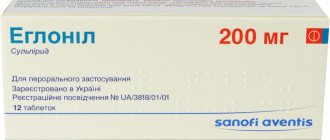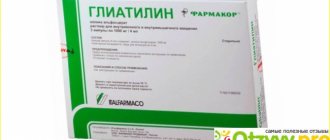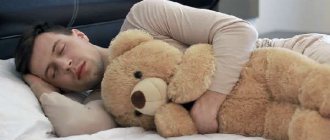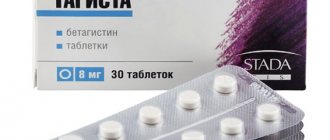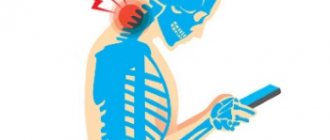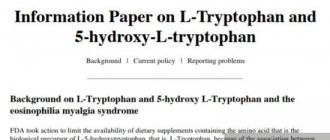7 positive
1 neutral
1 negative
- Write a review
Your rating for the drug:
(1 votes, average: 4.00 out of 5)
Donormyl is a hypnotic that belongs to the group of histamine H1 receptor blockers. The medicine is sold in the form of tablets for oral administration, consisting of the active component - doxylamine succinate. Donormil is prescribed to patients suffering from transient sleep disorders and is categorically not recommended for:
- personal intolerance to the components of the medication;
- diseases of the urethra and prostate gland with impaired urine flow;
- lactase deficiency;
- angle-closure glaucoma;
- under 15 years of age;
- congenital galactosemia, lactase deficiency and glucose-galactose malabsorption,
There have been no clinical studies on the use of the drug during hepatitis B, so it is not recommended to take it during this period. During pregnancy, it can be used at all stages.
The medication has a sedative effect, reduces the time to fall asleep and improves sleep quality. Metabolized in the liver and excreted through the kidneys and partly through the gastrointestinal tract. Donormil acts for 6-8 hours and causes virtually no side effects.
What is Donormil?
It is a sedative prescribed for people suffering from insomnia. Available in tablets and capsules. Also known as Sonmil. The active substance is doxylamine succinate, which has an m-anticholinergic effect.
When taking Donormil according to the instructions, those suffering from insomnia regain the ability to fall asleep. The duration of sleep increases. The drug helps relieve anxiety and restores the nervous system after neuroses.
The drug is taken 10-15 minutes before going to bed. Donormil does not affect biological sleep cycles. It also does not help cope with the physiological causes of insomnia. People with advanced insomnia or who are using the medication incorrectly will wake up several hours after taking the drug.
Side effects of the drug
Donormil is a strong sleeping pill. It is prescribed to those suffering from chronic insomnia. For a person who has mild sleep disorders, taking it has negative consequences. Having a depressing effect on the nervous system, it can cause a number of side effects:
- Paresis is a decrease in motor activity caused by depression of the nervous system.
- The appearance of drowsiness during the daytime.
- Constipation.
- Difficulty urinating.
- Mood swings during the day.
- Increased anxiety.
- Decreased attention level.
- Memory impairment.
- Apathy.
- Dry mouth.
Before starting treatment, you should consult a neurologist. If there is an individual intolerance to the active substance, use is contraindicated.
It is forbidden to give Donormil to children under 15 years of age, pregnant and lactating women, as well as those suffering from closed-angle glaucoma. It is not advisable to take the drug for those suffering from prostate adenoma, otherwise there is a risk of temporary loss of the ability to urinate.
People over 65 years of age should use Donormil with caution. It is unknown what reaction their body will have to sleeping pills. Old people often take several medications at once. It is not known which drug may cause incompatibility with this sleeping pill.
Related article: Can I drink Phenazepam and alcohol? Consequences of taking
General characteristics of the drug
Donormil is an excellent sedative. The drug is prescribed by a doctor once. That is, if a person has problems sleeping, the drug is prescribed to him once. The course of treatment can be prescribed for 2-3 weeks.
It should be taken immediately before bedtime . Within 15 minutes Donormil will begin its action, and the problem of insomnia will leave the person, if not forever, then for a long time. The drug will not only help you fall asleep quickly, but will also provide the necessary duration and quality of sleep. Donormil has a number of advantages over other sedatives. Advantages:
- the drug is sold without a prescription, freely;
- valid for 5−8 hours;
- After its use, no secondary effects occur, that is, after sleep there are no feelings of weakness, daytime drowsiness, or fatigue.
Like all medications, Donormil is no exception and has its own contraindications and side effects . The medicine is not recommended for children under 18 years of age, nursing mothers and pregnant women. Side effects of the drug include:
- impaired frequent urination and defecation;
- lethargy, drowsiness;
- feeling of dryness in the mouth;
- visual impairment.
The instructions for use indicate the incompatibility of the sleeping pill Donormil and alcohol. Therefore, before treatment you should consult your doctor. And also carefully read the indications, contraindications, and side effects.
Why is Donormil dangerous?
Because it has a strong depressant effect on the central nervous system. In this it is similar to other sedatives, which are recommended to be used with extreme caution.
The consequences are enhanced when Donormil is taken together with other sedatives. A fatal outcome is especially likely when combined with tranquilizers (Phenazepam, Alprazolam) and opioid analgesics (Codeine, Tramadol). Death occurs from excessive weakness and the inability of the nervous system to provide impulses for the respiratory system. Talk to your doctor before taking this drug together with other depressants and analgesics.
Phenazepam Alprazolam Codeine Tramadol
Another dangerous combination is the simultaneous use of Donormil with alcohol. Ethanol is a GABA receptor agonist. Entering the body, it has a sedative effect.
Like tranquilizers, alcohol increases the effect of the drug on the nervous system. The danger also lies in the fact that after drinking alcohol, people feel that the drug has too little effect on them, and they take more pills than they need. This leads to serious consequences, including coma and death.
And even if a person does not die from taking Donormil with alcohol at the same time, he will receive severe poisoning. After an overdose, nausea with profuse vomiting, elevated body temperature and dry mouth will begin. Delirium with intense frightening hallucinations also occurs.
When experiencing a drug overdose, a person constantly experiences severe anxiety, and the resulting auditory and visual hallucinations make him uncontrollable. In a state of delirium, a person can seriously harm themselves. For example, by attempting suicide.
Overdose of sleeping pills Donormil: can you die?
A drug like Donormil has a lethal dose, which worries patients. People suffering from chronic stress are forced to take a lot of sleeping pills to give their brains a rest after a day of work.
Donormil helps with insomnia, but has negative effects and is also used by some for suicide. People are prescribed sleeping pills all over the world, and most people do not have problems with overdoses. You don’t have to give up Donormil, but use it with caution.
What is Donormil?
It is a sedative prescribed for people suffering from insomnia. Available in tablets and capsules. Also known as Sonmil. The active substance is doxylamine succinate, which has an m-anticholinergic effect.
When taking Donormil according to the instructions, those suffering from insomnia regain the ability to fall asleep. The duration of sleep increases. The drug helps relieve anxiety and restores the nervous system after neuroses.
The drug is taken 10-15 minutes before going to bed. Donormil does not affect biological sleep cycles. It also does not help cope with the physiological causes of insomnia. People with advanced insomnia or who are using the medication incorrectly will wake up several hours after taking the drug.
Side effects of the drug
Donormil is a strong sleeping pill. It is prescribed to those suffering from chronic insomnia. For a person who has mild sleep disorders, taking it has negative consequences. Having a depressing effect on the nervous system, it can cause a number of side effects:
- Paresis is a decrease in motor activity caused by depression of the nervous system.
- The appearance of drowsiness during the daytime.
- Constipation.
- Difficulty urinating.
- Mood swings during the day.
- Increased anxiety.
- Decreased attention level.
- Memory impairment.
- Apathy.
- Dry mouth.
Before starting treatment, you should consult a neurologist. If there is an individual intolerance to the active substance, use is contraindicated.
It is forbidden to give Donormil to children under 15 years of age, pregnant and lactating women, as well as those suffering from closed-angle glaucoma. It is not advisable to take the drug for those suffering from prostate adenoma, otherwise there is a risk of temporary loss of the ability to urinate.
People over 65 years of age should use Donormil with caution. It is unknown what reaction their body will have to sleeping pills. Old people often take several medications at once. It is not known which drug may cause incompatibility with this sleeping pill.
Related article: Phenibut: compatibility with alcohol and consequences
Why is Donormil dangerous?
Because it has a strong depressant effect on the central nervous system. In this it is similar to other sedatives, which are recommended to be used with extreme caution.
The consequences are enhanced when Donormil is taken together with other sedatives.
A fatal outcome is especially likely when combined with tranquilizers (Phenazepam, Alprazolam) and opioid analgesics (Codeine, Tramadol).
Death occurs from excessive weakness and the inability of the nervous system to provide impulses for the respiratory system. Talk to your doctor before taking this drug together with other depressants and analgesics.
Phenazepam Alprazolam Codeine Tramadol
Another dangerous combination is the simultaneous use of Donormil with alcohol. Ethanol is a GABA receptor agonist. Entering the body, it has a sedative effect.
Like tranquilizers, alcohol increases the effect of the drug on the nervous system. The danger also lies in the fact that after drinking alcohol, people feel that the drug has too little effect on them, and they take more pills than they need. This leads to serious consequences, including coma and death.
And even if a person does not die from taking Donormil with alcohol at the same time, he will receive severe poisoning. After an overdose, nausea with profuse vomiting, elevated body temperature and dry mouth will begin. Delirium with intense frightening hallucinations also occurs.
When experiencing a drug overdose, a person constantly experiences severe anxiety, and the resulting auditory and visual hallucinations make him uncontrollable. In a state of delirium, a person can seriously harm themselves. For example, by attempting suicide.
Is Donormil considered a drug?
Unlike tranquilizers and opioid analgesics, often used to achieve a state of drug intoxication, the drug does not cause a euphoric state. The narcotic trip experienced from other sedatives cannot be obtained from Donormil, because its main effect is to quickly fall asleep.
Within 10 minutes after taking it, a person will simply fall asleep. No matter how much a person takes, he will not receive a pleasant sedative effect, and sleep can hardly be considered a narcotic effect.
Therefore, the drug has very little potential for narcotic use. However, it is not sold in Russia without prescriptions. Why it is banned in Russia without a prescription is unknown. There are no known cases of abuse of Donormil by drug addicts.
Proof of this is the fact that many patients who were prescribed Donormil soon switch to other sleeping pills. Too strong side effects, such as drowsiness during the day, cover the benefits of the drug.
When taken periodically, patients experience an increased tendency to experience sleep paralysis. Donormil makes the body fall asleep, leaving the brain to work. Consumers of sleeping pills can hardly be called drug addicts. Loading …
Is it possible to die from Donormil?
The drug has a sad reputation. It is actually used by people who have decided to commit suicide.
Pharmacologists have not clearly identified a lethal dose. To get poisoned, one person needs to eat a whole package, while another only needs a few tablets. This depends not only on the physiological data of the person, but also on what drugs he took before.
An overdose of a substance in itself does not lead to death. When looking for which pills you can take without waking up, Donormil is not the best choice.
But a person can attempt suicide by falling into a state of psychosis. Or choke on your own vomit in your sleep by mixing Donormil with alcohol.
Although Donormil cannot kill a person, it can leave significant damage to the body and psyche.
The harm to health will be even more severe if the person has previously suffered from mental disorders. An overdose survivor will experience chronic anxiety. It is possible that mental disorders that previously occurred in a latent form may develop.
Help with overdose
If someone near you has taken too many pills and is experiencing side effects from the drug, first ask what they have been taking. The maximum dosage of Donormil without mixing with other drugs differs from the dosage when mixed with alcohol and tranquilizers.
If a person took only Donormil, the likelihood of death is much lower. In any case, be sure to call a team of doctors. It doesn’t matter which pills caused the poisoning. In any case, it is necessary that the victim’s intestines are freed from tablets that have not yet been processed. To do this, induce vomiting several times.
A person who has received an overdose of Donormil has a sharp rise in temperature and uses more liquid than usual. The risk of dehydration is high, so the victim should be given regular water to drink periodically. But do not let him drink too much water, otherwise the body will not cope, and in addition to an overdose, doctors will struggle with excess water in the body.
It is advisable to give a person 50 g of activated carbon. In severe cases of overdose and inability to breathe, artificial ventilation is necessary.
Related article: Can I drink Phenazepam and alcohol? Consequences of taking
How to prevent an overdose?
The only way to avoid an overdose of Donormil is to follow the instructions. The dose should not be increased. To achieve fatal poisoning, a large dose is needed, but abuse leads not only to death, but also to other side effects.
Before taking, make sure that you are not allergic to lactose, as well as to the main active ingredient. Get tested in advance and also consult your doctor. If side effects occur, tell your doctor immediately.
Donormil is not the only sleeping pill. You may be prescribed Dormidol or similar medications.
You should not give sleeping pills to people who are suicidal. Suicide from Donormil is unlikely to happen, but the side effects will make a person suffering from depression suffer even more.
In a state of passion, people often do not understand whether it is possible to die from specific drugs, and swallow the first pills they come across. It is worth keeping them in a safe place, inaccessible to a potential suicide.
Lethal dose of sleeping pills
A dose sufficient to cause death has not yet been established. It is difficult to determine how many pills it will take to die. A handful of tablets will be lethal when mixed with opioid analgesics. However, if you take the same amount of Donormil without additional drugs, the person will be fine.
Lethal doses vary due to individual characteristics of the body. If you are intolerant to the active substance, it is much easier to get poisoned. It is unknown what will happen if a pack of Donormil is eaten by a person with a random set of physiological properties. However, you should not expect good consequences.
Precautionary rules
- Consult your doctor before taking sleeping pills. Donormil is not the most dangerous sleeping pill. The lethal number of tablets is overestimated compared to other drugs. But the mental side effects are too severe to forget about caution;
- Keep Donormil tablets in a safe place.
They can be found by chance not only by children, but also by people who are suicidal. The latter generally do not understand the danger of their actions with medicinal drugs; - Do not exceed the prescribed dose and duration of use.
The neurologist decides how long to take the drug. When taking the drug for several months, tolerance develops. Side effects persist, so it is better to take breaks.
Thus, the benefits of Donormil manifest themselves with careful use of the drug. Overuse increases the side effects. This product should not be abused.
It is also useless to use it as a means of suicide.
Source: https://otrav.net/otravleniya-lekarstvami/peredozirovka-snotvornym-donormil/
Is Donormil considered a drug?
Unlike tranquilizers and opioid analgesics, often used to achieve a state of drug intoxication, the drug does not cause a euphoric state. The narcotic trip experienced from other sedatives cannot be obtained from Donormil, because its main effect is to quickly fall asleep.
Within 10 minutes after taking it, a person will simply fall asleep. No matter how much a person takes, he will not receive a pleasant sedative effect, and sleep can hardly be considered a narcotic effect.
Therefore, the drug has very little potential for narcotic use. However, it is not sold in Russia without prescriptions. Why it is banned in Russia without a prescription is unknown. There are no known cases of abuse of Donormil by drug addicts.
Proof of this is the fact that many patients who were prescribed Donormil soon switch to other sleeping pills. Too strong side effects, such as drowsiness during the day, cover the benefits of the drug.
When taken periodically, patients experience an increased tendency to experience sleep paralysis. Donormil makes the body fall asleep, leaving the brain to work. Consumers of sleeping pills can hardly be called drug addicts.
Is it possible to die from Donormil?
The drug has a sad reputation. It is actually used by people who have decided to commit suicide.
Pharmacologists have not clearly identified a lethal dose. To get poisoned, one person needs to eat a whole package, while another only needs a few tablets. This depends not only on the physiological data of the person, but also on what drugs he took before.
An overdose of a substance in itself does not lead to death. When looking for which pills you can take without waking up, Donormil is not the best choice. But a person can attempt suicide by falling into a state of psychosis. Or choke on your own vomit in your sleep by mixing Donormil with alcohol. Although Donormil cannot kill a person, it can leave significant damage to the body and psyche.
The harm to health will be even more severe if the person has previously suffered from mental disorders. An overdose survivor will experience chronic anxiety. It is possible that mental disorders that previously occurred in a latent form may develop.
Known analogues
Television and other advertising have been actively promoting such drugs as Novo-passit and Afobazol for several years. Over-the-counter, affordable, safe.
Complex advertised herbal preparations (Novo-Passit) are even more expensive than Donormil. Afobazole is comparable in price.
What about action? In Novo-Passit it is more anti-anxiety and sedative than hypnotic. Afobazole generally has antidepressant properties. Its effect on sleep is very indirect, weak and slow.
Therefore, before you buy any advertised analogue of Donormil at the pharmacy without a prescription, ask your doctor whether it is worth it.
Help with overdose
If someone near you has taken too many pills and is experiencing side effects from the drug, first ask what they have been taking. The maximum dosage of Donormil without mixing with other drugs differs from the dosage when mixed with alcohol and tranquilizers.
If a person took only Donormil, the likelihood of death is much lower. In any case, be sure to call a team of doctors. It doesn’t matter which pills caused the poisoning. In any case, it is necessary that the victim’s intestines are freed from tablets that have not yet been processed. To do this, induce vomiting several times.
A person who has received an overdose of Donormil has a sharp rise in temperature and uses more liquid than usual. The risk of dehydration is high, so the victim should be given regular water to drink periodically. But do not let him drink too much water, otherwise the body will not cope, and in addition to an overdose, doctors will struggle with excess water in the body.
It is advisable to give a person 50 g of activated carbon. In severe cases of overdose and inability to breathe, artificial ventilation is necessary.
Related article: Symptoms of Paracetamol overdose: can you die from Paracetamol?
Cheap analogues
Products such as tincture (tablets) of motherwort or valerian cost less than 50 rubles per bottle (or, accordingly, blister). Some people use glycine as an inexpensive sleep aid: it also costs pennies.
If herbal remedies help you, then you can use them; if not, then there is no point in buying them. Their main effect is the placebo effect. Glycine helps some, but does not help many at all. Most often, an attempt to find an inexpensive analogue of Donormyl results in disappointment.
How to prevent an overdose?
The only way to avoid an overdose of Donormil is to follow the instructions. The dose should not be increased. To achieve fatal poisoning, a large dose is needed, but abuse leads not only to death, but also to other side effects.
Before taking, make sure that you are not allergic to lactose, as well as to the main active ingredient. Get tested in advance and also consult your doctor. If side effects occur, tell your doctor immediately.
Donormil is not the only sleeping pill. You may be prescribed Dormidol or similar medications.
You should not give sleeping pills to people who are suicidal. Suicide from Donormil is unlikely to happen, but the side effects will make a person suffering from depression suffer even more.
In a state of passion, people often do not understand whether it is possible to die from specific drugs, and swallow the first pills they come across. It is worth keeping them in a safe place, inaccessible to a potential suicide.
Lethal dose of sleeping pills
A dose sufficient to cause death has not yet been established. It is difficult to determine how many pills it will take to die. A handful of tablets will be lethal when mixed with opioid analgesics. However, if you take the same amount of Donormil without additional drugs, the person will be fine.
Lethal doses vary due to individual characteristics of the body. If you are intolerant to the active substance, it is much easier to get poisoned. It is unknown what will happen if a pack of Donormil is eaten by a person with a random set of physiological properties. However, you should not expect good consequences.
Precautionary rules
- Consult your doctor before taking sleeping pills. Donormil is not the most dangerous sleeping pill. The lethal number of tablets is overestimated compared to other drugs. But the mental side effects are too severe to forget about caution;
- Keep Donormil tablets in a safe place. They can be found by chance not only by children, but also by people who are suicidal. The latter generally do not understand the danger of their actions with medicinal drugs;
- Do not exceed the prescribed dose and duration of use. The neurologist decides how long to take the drug. When taking the drug for several months, tolerance develops. Side effects persist, so it is better to take breaks.
Thus, the benefits of Donormil manifest themselves with careful use of the drug. Overuse increases the side effects. This product should not be abused. It is also useless to use it as a means of suicide.
Use of the drug Donormil (doxylamine) in clinical practice
The main indications for prescribing Donormil are insomnia and sleep disorders. Contraindications for use: angle-closure glaucoma, difficulty urinating (diseases of the urethra and prostate), age under 15 years, lactation, hypersensitivity to the drug. Possible side effects are associated with the anticholinergic effect of the drug: dry mouth, impaired accommodation, constipation, urinary retention. It should be remembered that in the morning, after taking the drug in the evening, there may be a slower reaction and a feeling of dizziness, therefore, to prevent falling, sudden movements should be avoided. The drug is prescribed to adults and children over 15 years of age, 7.5–15 mg (½–1 tablet) per dose, 15 minutes before bedtime (in the evening). If necessary, the dose of Donormil can be increased to 30 mg per day. The film-coated tablet should be taken with water. The duration of treatment is from 2 to 5 days [6]. In case of an overdose of Donormil, which increases the side effects, agitation, mydriasis, paralysis of accommodation, flushing of the skin of the face and neck, hyperthermia, convulsions, and sinus tachycardia may appear. The phase of excitement and convulsions may be preceded by a state of depression. Such manifestations always require urgent therapy with the involvement of resuscitators. Modern clinical studies do not reveal serious side effects during treatment with therapeutic doses, but it is always necessary to remember the possible appearance of these symptoms that arise due to the individual characteristics of the body, and contraindications [10]. When Donormil is prescribed, daytime drowsiness may occur [1]. However, given the good safety profile of Donormial, it is recommended as a “first-line” drug in the treatment of chronic or newly diagnosed insomnia, unless the patient has obvious contraindications to the administration of this dosage form [3]. Currently, a disorder associated with difficulties in initiating and/or maintaining sleep, despite the presence of all the necessary conditions, is classified as insomnia [12]. Insomnia is a disorder associated with difficulty falling or staying asleep. According to DSM-IV, insomnia is defined as a deficiency in the quality and quantity of sleep necessary for normal daytime functioning. According to ICD-10, insomnia, hypersomnia and sleep rhythm disturbances are generally defined as “primarily psychogenic conditions with an emotionally caused disturbance in the quality, duration or rhythm of sleep” [5,15]. Use of Donormil in general somatic practice The prevalence of sleep disorders in the general somatic network is quite high. Thus, only severe insomnia, requiring drug correction, occurs in 14% of patients being treated in a hospital for any somatic disease [10]. Some surveys estimate that up to 20% of middle-aged people in the population require examination for sleep disorders [24]. Epidemiological studies on sleep disorders show that about 24% of people complain of sleep disorders – insomnia [18]. Sleep disorders can lead to temporary or long-term disability, and are often the cause of non-standard and emergency situations, which determines their medical and social significance [24]. The causes of insomnia are varied: stress, neuroses, mental neurological somatic diseases (including cardiovascular); psychotropic drugs, alcohol, toxic factors; endocrine-metabolic diseases, syndromes that occur during sleep (sleep apnea syndrome; motor disorders during sleep), pain phenomena, external unfavorable conditions (noise, humidity, etc.), shift work, jet lag, poor sleep hygiene. Most often, insomnia is associated with anxiety and depression and therefore can be considered a psychosomnic disorder [18]. A multicenter, randomized, double-blind, 3-parallel group study of 338 patients aged 18 to 73 years compared the efficacy and tolerability of Donormil (doxylamine) 15 mg with zolpidem 10 mg and placebo in the treatment of insomnia (including withdrawal studies). The high quality of sleep observed during therapy with the studied drugs persisted for 1 week after discontinuation of the drugs. Among the undesirable effects noted: drowsiness, asthenia, fatigue - in 13.5% of patients receiving Donormil (doxylamine), and in 6.7% of patients receiving zolpidem. Functional gastrointestinal disorders were more common with zolpidem (9.3%) than with placebo (7.3%) and Donormil (doxylamine) (7.2%). These manifestations resolved independently upon cessation of course therapy. The overall assessment of drug tolerability after 2 weeks of therapy was positive in 85% of cases. The study confirmed the advantage of Donormil over placebo in terms of hypnotic effects, which demonstrated high efficiency and good tolerability of the studied drugs without the development of “withdrawal syndrome” [4]. The most common breathing disorder during sleep is obstructive sleep apnea, a potentially life-threatening sleep apnea. Since sleep apnea is often combined with a decrease in air flow through the upper respiratory tract (hypopnea), it is customary to combine both of these conditions into a pathological syndrome complex - “obstructive sleep apnea-hypopnea syndrome” (OSAS). Respiratory disorders during sleep are accompanied by episodes of a pronounced decrease in arterial blood oxygen saturation (blood desaturation) and the development of hypoxia of the heart, brain, and kidneys. Hypoxia of these vital organs is usually accompanied by sudden changes in blood pressure and heart rhythm disturbances, which can lead to sudden death during sleep. The prevalence of obstructive sleep apnea syndrome among men aged 30–60 years is 4%, among women – 2%. The most important factors that influence the likelihood of developing OSA are body weight, gender, age, condition of the facial skeleton and the presence of ENT pathology [21]. The treatment program for patients with OSAHS includes basic (CPAP machine, dental (oral) applicators) and conservative (weight loss, side sleeping, abstinence from alcohol for 2 or 3 hours before bedtime, abstinence from certain pharmacological agents, smoking cessation) treatment tactics that are aimed at maintaining the constancy of the airway lumen during sleep. In case of even minimal suspicion of the presence of OSAHS as a cause of insomnia and the impossibility of polysomnographic verification, it is better to use Donormil as a sleeping pill, the duration of which should not exceed 3 weeks (optimally 10–14 days). [3,5,9,11]. Each person needs a different amount of sleep; the average nightly sleep requirement for an adult is 7–8 hours, although variations from this norm are quite wide. Some people feel great after 5-6 hours of sleep, while others need 9-10 hours. With age, the number of people with short sleep duration (less than 6 hours) increases: 18–25 years old – 12%, 26–35 years old – 20.8%, 46–60 years old – 61% [8]. The clinical phenomenology of insomnia includes presomnic, intrasomnic and postsomnic disorders. An objective study of patients with insomnia necessarily includes polysomnography. This technique involves the simultaneous recording of several parameters, such as electroencephalography, electromyography, electrooculography, which is the minimum required set for assessing sleep structure [12–15]. More than 20% of middle-aged patients and 36% of elderly patients complain of all three types of sleep disorders, and these groups are usually the most difficult to manage. Patients often complain of a complete lack of sleep for many nights, but with an objective polysomnographic study, sleep is not only present, but its duration exceeds 5 hours (sometimes reaching 8 hours), and the structure of sleep is not too deformed. This situation is defined as sleep agnosia. The cause of its occurrence has not been determined, but more often a similar phenomenon is observed in women aged 46 to 60 years who do not have severe emotional and somatic disorders, and in patients suffering from mental illnesses [7]. To clinically assess the severity of insomnia, a 5-point sleep scale questionnaire is used, which includes the following indicators: time of falling asleep, duration of sleep, number of night awakenings, quality of sleep, number of dreams, quality of morning awakening. A score below 19 points is a sign of trouble [16]. Prescription of Donormil in cardiac patients Any sleep disorders have a negative impact on human health, since sleep is the most important regulator of the body's circadian (circadian) biological rhythms. Cardiovascular pathology itself creates conditions for disruption of human circadian rhythms. The existing circadian changes are also accompanied by sleep disturbances, which accompany and aggravate the course of cardiovascular diseases [1,2]. These disturbances in the biological rhythms of hormonal levels and hemodynamics indicate a state of tension in the cardiovascular system precisely in the evening and night hours. Sadovnikova I.I. statistical data are presented: the maximum frequency of development of hypertensive crises occurs in the period of 16–24 hours, especially from 19 to 23 hours; acute left ventricular failure – 21–23 hours; myocardial infarction – in the period of 1–2 hours, two peaks – morning (8–10 o’clock) and evening (17–18 o’clock); recurrence of myocardial infarction – 0–3 hours, 15–16 hours, 19–21 hours; pulmonary edema – from 19:00 to 3:00; paroxysmal tachyarrhythmia – 15–19 hours; ventricular fibrillation – 4–10 hours, 17–20 hours. The existing circadian changes (mainly at night) in these patients are accompanied by sleep disturbance and depressive syndrome, which necessarily accompanies IHD and hypertension. This implies the need and expediency of assessing the patient’s complaints about changes in sleep and mandatory correction of these deviations [22]. In patients with cardiovascular pathology, as a rule, two types of sleep disorders are distinguished: disorders with predominantly early awakenings and disorders with frequent awakenings at night. In the study of Adamenko R.Ya. (2005) included 62 patients (20 men and 42 women aged 46–78 years) whose sleep disturbances were associated with arterial hypertension (AH). All patients presented pre-, intra- or post-somnic complaints to one degree or another. For the treatment of sleep disorders, all patients were prescribed Donormil at a dose of 7.5–15 mg nightly, 15 minutes before bedtime. In all patients, as a result of treatment, the time to fall asleep was significantly reduced (to normal values), normal sleep duration occurred, presomnia disorders disappeared, night awakenings were observed less frequently, and the level of wakefulness after sleep improved [11]. 20% of myocardial infarctions and 15% of cases of sudden death occur during night sleep, while myocardial infarctions that develop at night have a more severe course and poor prognosis. Angina attacks also often occur in the evening and at night and cause insomnia. The emotional stress of patients with angina pectoris increases due to the fear of another attack and death in their sleep. In patients suffering from coronary artery disease, night apnea can provoke rhythm disturbances in the form of ventricular tachycardia; in some cases, the development of atrioventricular block of II–III degree is possible. One of the reasons for the low effectiveness of antihypertensive therapy is sleep disturbance, which, according to the literature, is observed in approximately 42% of patients with hypertension. Sleep disturbance leads to an increase in average daily blood pressure due to an increase in night pressure. In such patients, the period of wakefulness is extended with higher blood pressure numbers and an increase in blood pressure the next day, and the degree of nighttime decrease in blood pressure decreases. All this leads to the appearance of a pathological type of daily blood pressure curve. In order to correct sleep disorders in cardiac patients, benzodiazepine drugs are traditionally used, although they do not always meet the requirements of effectiveness and safety. Often, while taking these drugs, there is an excessive sedative effect, which is difficult for cardiac patients suffering from asthenia. It is also possible that cognitive deficits may increase, which contributes to social maladjustment. Some benzodiazepines can cause vascular hypotension in the elderly and in patients with impaired vascular tone. In patients with coronary heart disease, reflex tachycardia may develop. In cardiological practice, Donormil is prescribed in a dose of 15 mg, ½–1 tablet per 30 minutes. before sleep. [2]. Prescribing Donormil to neurological patients Data from studies conducted in a number of clinics in Ukraine indicate that sleep disorders are present in 86.5% of patients hospitalized in neurological departments [8]. Currently, in the arsenal of doctors, primarily somnologists and neurologists, for the drug treatment of sleep disorders there are three generations of sleeping pills: 1st generation - barbiturates, antihistamines, chloral hydrate, propanediol, paraldehyde; 2nd generation – benzodiazepine derivatives – nitrazepam, diazepam, etc.; 3rd generation – cyclopyrrolone derivatives (zopiclone) and imidazopyridine derivatives (zolpidem). The limitation in the use of these drugs is their side effects (they can disrupt daytime wakefulness and also cause drug dependence). But even now, drugs of this group are actively used to treat insomnia, especially in combination with anxiety disorders. Along with the synthesis of drugs aimed strictly at the treatment of sleep disorders, drugs from other pharmacological groups are constantly being studied, the effects of which include sleeping pills. Such drugs include Donormil (doxylamine succinate) [10]. Unlike benzodiazepine derivatives, Donormil not only increases the duration and improves the quality of sleep, but also does not disrupt the physiological phases of normal sleep and circadian rhythms. Perhaps this is the only sleeping pill that has no contraindications regarding the possibility of developing sleep apnea [11]. On the territory of the Russian Federation, an open non-comparative study of the drug Donormil was conducted in 50 patients with insomnia aged from 24 to 60 years, undergoing outpatient and inpatient treatment in sleep centers and a neurological department (10 patients were examined using polysomnography). All patients took Donormil 15 mg 15 minutes before bedtime for 10 days. As a result of the study of the effect of Donormil on patients with insomnia, a positive dynamics of subjective sleep characteristics was obtained (14.4 points “before” vs. 19.7 points “after”), the results of the “sleep apnea” screening questionnaire (3.0 points “ before" vs 2.9 b. "after"). Subjective feelings of a positive effect are confirmed by studies of sleep structure undergoing positive changes, which affect such indicators as sleep duration (305.3 minutes “before” vs 341.6 minutes “after”), duration of falling asleep (49.3 minutes “before” vs 21.1 minutes “after”), REM sleep phase (43.1 minutes “before” vs 56.7 minutes “after”). It has been shown that Donormil has a greater effect on patients with more severe sleep disorganization. It was concluded that, given its high effectiveness and safety, Donormil can be recommended to a wide range of patients with sleep disorders, both acute and chronic insomnia [14]. When taking Donormil as a sleeping pill, the natural structure of sleep is preserved, there is no addiction or dependence (withdrawal syndrome does not develop), the use of the drug is not accompanied by deterioration of cognitive functions. In a study conducted at the Moscow City Somnology Center and the Department of Nervous Diseases of the First Moscow State Medical University named after I.M. Sechenov demonstrated the effectiveness of Donormil in relation to both subjective (according to questionnaires) and objective (according to polysomnography) sleep indicators in patients with insomnia. When comparing the data of these patients before and after treatment, an improvement in the total score of sleep quality was revealed by 37%, there was a significant (at p<0.05) increase in sleep duration, delta sleep latency time and the amount of REM sleep, a decrease in the time of falling asleep and sleep quality index. There was no negative effect of the drug on breathing parameters during sleep [19,20]. A study was conducted to evaluate the effectiveness of the use of antidepressants (using the example of paroxetine from the group of serotonin reuptake inhibitors) in combination with Donormil in the treatment of sleep disorders in patients with post-stroke depression [16]. The study included 49 patients (24 women and 25 men) who had suffered a stroke (2-3 weeks ago), aged from 47 to 64 years. The average score on the CES - D depression scale was 26.4 ± 1.9, which corresponds to a mild and moderate degree of depression. In all studied patients with depression, pronounced sleep disorders were noted - the sum of the points on the subject of the subjective characteristics of sleep was 16.1 ± 0.6. Patients were divided into two groups: the main (n = 27) - receiving 20 mg of paroxetine in combination with 15 mg of donormil at night, and the control - received only paroxetine. The dynamics of the state was estimated after 14 and 21 days. The study showed that the integrated use of paroxetine and donation contributed to a reliable improvement of sleep indicators in patients with the main group by 30% with a simultaneous reduction in the severity of depressive disorders by 26.1% by the end of the 2nd week of treatment. In the control group for this temporary interval, reliable changes in the indicators under study were not noted. A second study after 3 weeks showed: in the main group, the total score on the scale of the subjective characteristics of sleep was 26.6 ± 0.5, the average score along the CES - D depression scale against the background of depression reduction - 16.2 ± 1.7; In the control group, the improvement of sleep indicators to 21.0 ± 0.7 points, a decrease in depression indicators to 17.1 ± 1.6 points. Thus, the treatment of sleep disturbances in patients with post -industry depression is advisable to carry out a combination of antidepressant from the group of reverse capture of serotonin and donormil. In a study of chronic cerebrovascular diseases, a high frequency of Inssonia was revealed: 85% of patients with discirculatory encephalopathy of 426 examined expressed complaints about the quality and duration of night sleep. A study was conducted on the study of the tolerance and effectiveness of donormil (doxilamin) for insessonia in patients with discirculatory encephalopathy, in which the quality and quantitative indicators of sleep before and after treatment with donormil were carried out [23]. The study included 30 patients (22 women and 8 men) with a diagnosis of discirculatory atherosclerotic encephalopathy I and II, aged 55 to 68 years. In the group of patients, complaints about sleep disorders, increased fatigue, headaches, decreased memory and attention, instability of gait, impairment of hearing and vision prevailed. The frequency of manifestation of insomnic disorders is from 3 to 7 times a week, duration of 2 months. up to 3 years. To objectify sleep disturbances, a questionnaire was used. Presomnical disorders were noted in 20%, post -soot in - 16.7% and intracnial - in 63.3% of cases. The instrumental study included electroencephalography, rheoencephalography and computed X -ray tomography of the brain. Patients under the age of 60 (73.3%) were prescribed at a dose of 15 mg (1 tablet), older than 60 years (26.7%) - 7.5 mg (1/2 tablets) 15 minutes before going to bed within 10 days. During the study, a reliable improvement in the quality of sleep quality was obtained: the time of falling asleep decreased, the number of anxious dreams and night awakenings decreased, the lack of drowsiness and general weakness in the morning was noted. The total duration of sleep after treatment has approached physiological indicators - this corresponds to an increase in the total score of 49.6%. There were no undesirable phenomena during the administration of the donor. Thus, the results indicate the high effectiveness of donation in sleep disorders, its good tolerance and the possibility of recommending the drug for correction of chronic imbalance in patients with discirculatory encephalopathy [23]. Fibromyalgia, one of the causes of sleep disturbance is a diffuse, symmetrical non -devastating pain, which is chronic and accompanied by stiffness, depression, sleep disturbances and the presence of characteristic pain points. Sleep disturbances in fibromyalgia are almost a bodge of it [25]. The representation of fibromyalgia is about 4% in the population, 6-10% in general clinical practice and over 15% in rheumatological. Active complaints of patients about the difficulties of falling asleep, frequent awakening in the middle of the night and superficial sleep are observed in 74.6% of patients. At the same time, the most serious complaints about the absence of a feeling of rest after a night sleep, which served as the basis for denoting a dream in fibromyalgia, as an “non -contingal” - this phenomenon is noted in 96% of cases. The polysonographic pattern of sleep in patients with fibromyalgia is characterized by an increase in the representation of the surface stages of sleep, the time of wakefulness inside the night, movements in the dream, reduction of the phase of quick sleep [25]. The aggravating factor in sleep disturbance in patients with fibromyalgia is depressive disorders. In approximately 64% of cases, depressive episodes precede the appearance of the main symptoms of the disease, 71% in the history of the previously depressive disorders, when analyzing which certain polysographic features were shown depending on the level of depression, namely, with an increase in the level of depression, the time of wakefulness increases In a dream, the activation index of movements of the 1st stage, the number of "carotid" spindles is reduced [25]. A special randomized double -related placebo -controlled study of the effect of donormil (doxylamine) on the structure of sleep and the state of cognitive functions, memory and reaction rate with a single administration of 15 mg of donormil (doxilaminat) or placebo in healthy volunteers was carried out. The indicators of the total duration of sleep, the number of awakenings during sleep, the number of sleep cycles in the group of doxilamin and placebo did not differ. After taking a donor (doxilamin), the total duration of awakening during sleep was significantly reduced. Reception of a donormil (doxilamin) leads to a significant shortening of the first stage and lengthening the second stage. At the same time, donormil (doxylamine) does not affect the duration of the third and fourth stages and phases of quick sleep [15]. The appointment of a donormil in psychiatric practice conducted an open study on assessing the effectiveness of a donormil in a psychiatric clinic and determining the contingent of rector patients with borderline conditions and low -processing endogenous diseases [24]. The study was attended by 61 patients (28 men, 33 women, the average age - 42.16 ± 14.5 years), who was treated stationary or outpatiently in the clinic of the department for the study of border mental pathology and psychosomatic disorders of the NCPZ RAMS. Patients turned regarding anxious -phobic, depressive, astheno -apatical and hypochondriacal disorders, within the framework of which complaints of sleep disturbances were noted. The dynamics of the condition of patients was evaluated in the background and on the 15th day of therapy using psychopathological and psychometric (assessment of the subjective characteristics of sleep) examination methods. The donor was prescribed in doses from 7.5 to 30 mg in tablet or soluble form in 30 minutes. before going to bed (course - 15 calendar days). If there was no effect within 5 days, the course of treatment was stopped. The donor was prescribed in combination with other psychotropic drugs, but not simultaneously with tranquilizers, the evening intake of other drugs was moved to 18.00. At 50.8%, spontaneous sleep disturbances were identified, in 18% - situationally determined. The study was completely completed 68.8% of patients. In the analysis of psychopathological manifestations that determine the symptoms of Inssonia in this part of observations, it was revealed that in 53.1% of cases there is depressive, 4.3% anxious -phobic syndrome; There have also been cases of reduction of symptoms of insomnia, which developed within the framework of hypochondriacal (17.6%) and astheno -apatic (25%) disorders, respectively. In the course of the study, reliable changes in indicators were obtained to reduce the period of falling asleep - 73.8%, improving the quality of sleep (increase in depth and a decrease in the number of dreams), improving the quality of morning awakening (vigor, lack of drowsiness and breakdown, desire to lie in bed). It is noted that the drug practically does not affect the amount of night awakening. Unwanted phenomena are registered in 21.4% of the total number of responders in the form of a short -term (no more than 30 minutes) morning lethargy and drowsiness, and outpatient patients additionally reported the difficulties of including in labor activities that are reduced during the first 5 days of taking the drug independently or independently or With a decrease in the dose to 7.5 mg. Thus, donormil is effective for sleep disturbances in medium and mild severity that arose as an element of depressive, anxious -phobic, asthenapathic and hypochondriacal syndromes, or sleep disturbances forming as part of personality disorders, affective pathology of the cyclotic level or inaccidently -like (psychopathic) schizophrenia. Treatment of sleep disorders with a donormil is not accompanied by the effect of the Beginning. Given the data on the high efficiency and safety of the drug Donormil can be recommended to a wide range of patients with sleep disorders, which are formed during the pathology of the circle of "small" psychiatry. The use of donormil in obstetric and gynecological practice from 50 to 90% [17], according to other sources, 70–85% [26], all pregnant women suffer from nausea and vomiting (morning malaise of pregnant women). The effectiveness of doxilamin, which is prescribed for the treatment of nausea and vomiting in pregnant women, compared to placebo, has been proven. Numerous studies have not revealed the teratogenic effect of the drug on the fetus. It is effective to prescribe a doxilam 25 mg at night independently or in combination with pyridoxine 25 mg three times a day [17]. A randomized, double -blind, multicenter placebo -controlled study of the effectiveness of the effectiveness of the drug diclectin in pregnant women with complaints of nausea and vomiting was carried out [27]. The study included women (n = 131) who took diclectin (doxylamine succinate + pyrodoxin hydrochloride), and a group of women (n = 125) taking placebo. All symptoms were evaluated in points on special scales. The duration of the observation was 14 days. In the course of the study, it was shown that the prescription of diklectin to a greater extent of severity reduces the symptoms of nausea and vomiting in comparison with placebo (–4.8 ± 2.7 vs –3.9 ± 2.6) and increases the quality of life of patients. After the test was completed, 48.9% of women taking diclectin expressed the desire to continue taking the drug compared to 32.8% of women from the placebo group. Thus, the form of the release of the drug Diklectin, which contains doxils and pyridoxine, is the most effective nausea and vomiting in pregnant women [27]. Another randomized study was carried out on the assessment of effectiveness by different methods of nausea and /or vomiting at the early stages of pregnancy [26]. 21 women with a mild severity of nausea and vomiting of pregnant women were selected in the study. Such methods of treating nausea in pregnant women as antihistamines, pyridoxine, acupressure and ginger root extract were used. The reduction of the frequency of manifestation of symptoms of nausea in the prescription of anti -excavation agents has been noted. The effectiveness of all the means used is shown. During the study of teratogenic effects on the fetus from the use of each of the funds, no means were noted. Thus, we can conclude on the safety of the appointment of Debenddox, which includes a pre -oxylamin of a succinate, in the treatment of nausea in the early stages of pregnancy. The conclusion in a number of studies notes the high effectiveness of the drug donormil in the treatment of insomnic disorders in patients in somnological, general somatic, cardiological, neurological, psychiatric, gynecological practice. The optimal dosing mode is 7.5–15 mg, in some cases up to 30 mg per day, 15 minutes before bedtime, a course of up to 14-15 days. The drug can be assigned to pregnant women with early pregnancy. The safety of the drug and its good tolerance are proved. Literature 1. Artyukhova M.G. Sleep disorders in cardiological patients // breast cancer. - 2010. - Volume 18. - No. 8 - S. 460–464. 2. Artyukhova M.G., Shaneva I.A. The structure and features of the treatment of sleep disorders in patients with cardiovascular diseases // breast cancer. - 2010. - Volume 18. - No. 26. - P.1573–1578. 3. Babak S.L., Golubev L.A. Respiratory disorders during sleep: Modern therapeutic tactics // Handbook of a clinical doctor. - 2007. - Volume 5. - No. 7. – P.28–33. 4. Babak S.L., Golubev L.A., Gorbunova M.V. Chronic inshasonia in the clinical practice of the therapist // RMG. - 2008. - Volume 16. - No. 5. - P.259–266. 5. Babak S.L., Chuchalin A.G. Sleep disorders and respiratory disorders during sleep in the practice of the therapist // RMG. - 2006. - Volume 14. - No. 16. - p.1166–1171. 6. Donormil: Instructions for use. URL: https://www.rlsnet.ru/tn_idex_id_1356.htm 7. Insomnia and principles of its treatment // https://www.medline.uz/article/neurogoly/698.htm 8. Kalmykova T.N., orphan N.V. Sleep disorders: a modern view of the problem, pharmacological correction // LIKI Ukrainian. - 2002. - No. 12. - S.40–41. 9. Kovrov G.V., Lyubshina O.V. Modern trends in the diagnosis and treatment of Inssonia // RMG. - 2007. - Volume 15. - No. 4. - p. 202–206. 10. Kovrov G.V., Machulina A.I., Lyubshina O.V. Prospects for the use of donormil in the treatment of Inssonia // breast cancer. - 2007. - Volume 15. - No. 24. - P.1788–1794. 11. Kovrov G.V., Vorobyova O.V. Sleep violation: from a complaint to diagnosis and treatment // breast cancer. - 2006. - Volume 14. - No. 6. - S.439–444. 12. Levin Ya.I. Doxylamine (donormil) in the treatment of Inssonia // breast cancer. - 2006. - Volume 14. - No. 9. - S. 704–709. 13. Levin Ya.I. Doxylamine and insomnia // Consilium Medicum. - 2006. - Volume 8. - No. 8. - P.114–115. 14. Levin Ya.I., Strygin K.N. Donormal in therapy of Inssonia // Treatment of nervous diseases. - 2005. - Volume 6. - No. 2 (16). - P.18–21. 15. Levin Ya.I. Sleep, insomnia, doxylamine (donormil) // breast cancer. - 2007. - Volume 15. - No. 10. - S.850–855. 16. Markin S.P. Depressive disorders in the clinical picture of the brain stroke // breast cancer. - 2008. - Volume 16. - No. 26. - P.1753–1758. 17. Megley S.V. Early gestosis (emesis) // https://libmedi.ru/opp/4/5768 18. Ostroumova O.D. Snowsticks (hypnotic drugs) in the practice of a therapist // RMG. - 2010. - Volume 18. - No. 18. - p.1122–1128. 19. Poloektov M.G. Disorders of sleep at the young age of Inssonia and breathing disorders in a dream // attending physician. - 2011. - No. 5. - S. 20. Poloektov M.G. Inssia and breathing disorders in a dream: Correction capabilities // RMG. - 2011. - Volume 19. - No. 15. - S.948–954. 21. Poloektov M.G. Insonia: diagnostics and correction capabilities // attending physician. - 2010. - No. 10. - S.79–82. 22. Sadovnikova I.I. The problem of Inssonia in the practice of a cardiologist // RMG. - 2006. - Volume 14. - No. 10. - S.770–774. 23. Smirnov A.A., Gustov A.V., Zheltova O.Yu. The effectiveness of the use of donormil in the treatment of insanity in patients with discirculatory encephalopathy // Journal of Neurology and Psychiatry named after S.S. Korsakov. - 2006. - No. 3. - S.56–57. 24. Smulevich A.B., Pavlova L.K., Zheleznova M.V. The use of the drug donormil in the treatment of sleep disturbances of medium and mild severity // breast cancer. - 2006. - Volume 14. - No. 23. - P.1714–1719. 25. Tabeeva G.R. Sleep disorders in patients with fibromyalgia // breast cancer. - 2006. - Volume 14. - No. 21. —P. 1530–1535. 26. Jewell D., Young G. Internationals for Nausea and Vomiting in Early Pregnancy // Cochrane Database Syst Rev. - 2010. - No. 9: CD000145. 27. Koren G., Clark S., Hankins GD, Caritis Sn, Miodovnik M., Umans JG, Mattison DR Effectivence of Delayed - Release Doxylamine and Pyridoxine for Nause and Vomiting of Pregnancy: a R Andomized Placebo Controlled Trial // Am J Obstet Gynecol. - 2010. - Vol.203. - No. 6. - R. 571.e1–7.
